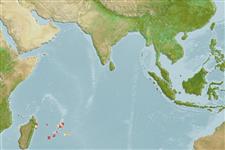Classification / Names
Nombres comunes | Sinónimos | Catalog of Fishes(Género, Especie) | ITIS | CoL | WoRMS | Cloffa
>
Blenniiformes (Blennies) >
Blenniidae (Combtooth blennies) > Salariinae
Etymology: Cirripectes: Latin, cirrus = curl fringe + Greek, pektos, -e, -on = made of several parts solidly united (Ref. 45335); randalli: Named for Dr. J. E. Randall..
Environment: milieu / climate zone / depth range / distribution range
Ecología
marino demersal; rango de profundidad 0 - 8 m (Ref. 529). Tropical; 15°S - 23°S
Western Indian Ocean: known only from Mauritius and Cargados Carajos Shoals. Recently reported from Reunion (Ref. 53568).
Length at first maturity / Tamaño / Peso / Age
Maturity: Lm ?, range 9 - ? cm
Max length : 10.7 cm SL macho / no sexado; (Ref. 529)
Espinas dorsales (total): 12; Radios blandos dorsales (total): 14-15; Espinas anales 2; Radios blandos anales: 15 - 16; Vértebra: 30. Diagnosis: Dorsal fin XII, 14, membrane attached to caudal fin, with deep notch above last spine, first spine about equal to second; anal fin II, 16; pectoral rays 15; pelvic fin I, 4; caudal fin procurrent rays 10-12. Vertebrae 10 + 20. Last epipleural rib modally on vertebral centrum 19. LL, without scales and scalelike flaps; LL tubes 1-7, canal ends on caudal-fin base. Lower lip smooth mesially, plicate laterally. Upper lip crenulae 36-43. Gill rakers 26-27. Cephalic sensory pore system complex, no pores at the extra interorbital position. Midsnout pores present. Cirri, supraorbital 12-26, nasal 10-18; nuchal cirri 36-42, in 4 groups, ventralmost group borne on a slightly expanded flap. Body spots, extending to basal half of dorsal, anal and caudal fins in females but not in males (Ref. 529).
Facultative air-breathing in the genus (Ref. 126274); Adults occur on coral patches in surge channels of rocky reefs with light surf, 0-8 m deep (Ref. 529). Oviparous. Eggs are demersal and adhesive (Ref. 205), and are attached to the substrate via a filamentous, adhesive pad or pedestal (Ref. 94114). Larvae are planktonic, often found in shallow, coastal waters (Ref. 94114).
Life cycle and mating behavior
Madurez | Reproducción | Puesta | Huevos | Fecundidad | Larva
Oviparous, distinct pairing (Ref. 205). Urogenital orifice of male genital papilla located basally between 2 widely separated slender filaments on a fleshy swelling behind anus; testes bulbous with length equal its width (Ref. 205).
Williams, J.T., 1988. Revision and phylogenetic relationships of the blenniid fish genus Cirripectes. Indo-Pac. Fish. (17):78 p. (Ref. 529)
IUCN Red List Status (Ref. 130435)
Threat to humans
Harmless
Human uses
Pesquerías: sin interés
Más información
ReferenciasAcuiculturaPerfil de acuiculturaRazasGenéticaElectrophoresesheritabilidadEnfermedadesProcesamientoNutrientsMass conversion
ColaboradoresImágenesStamps, Coins Misc.SonidosCiguateraVelocidadTipo de nataciónSuperficie branquialOtolitosCerebrosVisión
Herramientas
Special reports
Download XML
Fuentes de Internet
Estimates based on models
Preferred temperature (Ref.
123201): 25.4 - 26.8, mean 26.2 °C (based on 28 cells).
Phylogenetic diversity index (Ref.
82804): PD
50 = 0.5000 [Uniqueness, from 0.5 = low to 2.0 = high].
Bayesian length-weight: a=0.01072 (0.00480 - 0.02393), b=3.01 (2.82 - 3.20), in cm total length, based on LWR estimates for this (Sub)family-body shape (Ref.
93245).
Nivel trófico (Ref.
69278): 2.0 ±0.00 se; based on food items.
Resiliencia (Ref.
120179): Alto, población duplicada en un tiempo mínimo inferior a 15 meses (Preliminary K or Fecundity.).
Fishing Vulnerability (Ref.
59153): Low vulnerability (10 of 100).
